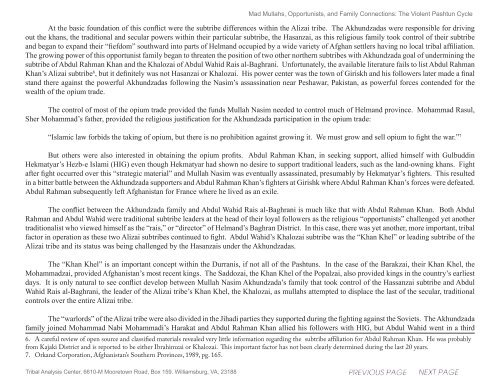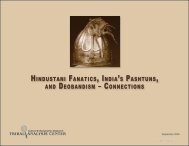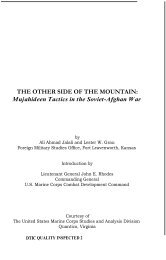Mad Mullahs, Opportunists, and Family Connections: The Violent Pashtun CycleAt the basic foundation of this conflict were the subtribe differences within the Alizai tribe. The Akhundzadas were responsible for drivingout the khans, the traditional and secular powers within their particular subtribe, the Hasanzai, as this religious family took control of their subtribeand began to expand their “fiefdom” southward into parts of Helmand occupied by a wide variety of Afghan settlers having no local tribal affiliation.The growing power of this opportunist family began to threaten the position of two other northern subtribes with Akhundzada goal of undermining thesubtribe of Abdul Rahman Khan and the Khalozai of Abdul Wahid Rais al-Baghrani. Unfortunately, the available literature fails to list Abdul RahmanKhan’s Alizai subtribe 6 , but it definitely was not Hasanzai or Khalozai. His power center was the town of Giriskh and his followers later made a finalstand there against the powerful Akhundzadas following the Nasim’s assassination near Peshawar, Pakistan, as powerful forces contended for thewealth of the opium trade.The control of most of the opium trade provided the funds Mullah Nasim needed to control much of Helmand province. Mohammad Rasul,Sher Mohammad’s father, provided the religious justification for the Akhundzada participation in the opium trade:“Islamic law forbids the taking of opium, but there is no prohibition against growing it. We must grow and sell opium to fight the war.” 7But others were also interested in obtaining the opium profits. Abdul Rahman Khan, in seeking support, allied himself with GulbuddinHekmatyar’s Hezb-e Islami (HIG) even though Hekmatyar had shown no desire to support traditional leaders, such as the land-owning khans. Fightafter fight occurred over this “strategic material” and Mullah Nasim was eventually assassinated, presumably by Hekmatyar’s fighters. This resultedin a bitter battle between the Akhundzada supporters and Abdul Rahman Khan’s fighters at Girishk where Abdul Rahman Khan’s forces were defeated.Abdul Rahman subsequently left Afghanistan for France where he lived as an exile.The conflict between the Akhundzada family and Abdul Wahid Rais al-Baghrani is much like that with Abdul Rahman Khan. Both AbdulRahman and Abdul Wahid were traditional subtribe leaders at the head of their loyal followers as the religious “opportunists” challenged yet anothertraditionalist who viewed himself as the “rais,” or “director” of Helmand’s Baghran District. In this case, there was yet another, more important, tribalfactor in operation as these two Alizai subtribes continued to fight. Abdul Wahid’s Khalozai subtribe was the “Khan Khel” or leading subtribe of theAlizai tribe and its status was being challenged by the Hasanzais under the Akhundzadas.The “Khan Khel” is an important concept within the Durranis, if not all of the Pashtuns. In the case of the Barakzai, their Khan Khel, theMohammadzai, provided Afghanistan’s most recent kings. The Saddozai, the Khan Khel of the Popalzai, also provided kings in the country’s earliestdays. It is only natural to see conflict develop between Mullah Nasim Akhundzada’s family that took control of the Hassanzai subtribe and AbdulWahid Rais al-Baghrani, the leader of the Alizai tribe’s Khan Khel, the Khalozai, as mullahs attempted to displace the last of the secular, traditionalcontrols over the entire Alizai tribe.The “warlords” of the Alizai tribe were also divided in the Jihadi parties they supported during the fighting against the Soviets. The Akhundzadafamily joined Mohammad Nabi Mohammadi’s Harakat and Abdul Rahman Khan allied his followers with HIG, but Abdul Wahid went in a third6. A careful review of open source and classified materials revealed very little information regarding the subtribe affiliation for Abdul Rahman Khan. He was probablyfrom Kajaki District and is reported to be either Ibrahimzai or Khalozai. This important factor has not been clearly determined during the last 20 years.7. Orkand Corporation, Afghanistan’s Southern Provinces, 1989, pg. 165.Tribal Analysis Center, 6610-M Mooretown Road, Box 159. Williamsburg, VA, 23188
Mad Mullahs, Opportunists, and Family Connections: The Violent Pashtun Cycledirection by entering the Jamiat-i Islami party of Professor Burhanuddin Rabbani, a party dominated by Tajiks. Their reasons for the choices maderemain unknown, but it may be as simple as opposition to the selection made by the others as they joined separate parties because of their inter-tribalanimosities – further splitting the Alizai tribe. But at the bottom of the animosities lay a single factor as religious “opportunists” challenged the seculardominance of the traditional khans, represented by both Abdul Rahman Khan and Abdul Wahid Rais al-Baghrani.Curiously, the emergence of the “Akhundzada” family as religious opportunists appears to be an isolated occurrence within the region ofAfghanistan dominated by the Durrani Confederation. While serving to illustrate the malik vs. mullah theme very well, these opportunists may haveemerged from the chaos of the early communist period due to the presence of Helmand province’s lucrative opium industry. Opium was probably thereason for the fighting between Mohammad Nasim’s Harakat and Gulbuddin Hekmatyar’s HIG, represented in Helmand province by Abdul RahmanKhan. It was far more common to see religious opportunists challenging the authority of secular khans and maliks in regions of Pashtun territorywhere confederations did not exist, such as Pakistan’s Northwest Frontier Province and its Federally Administered Tribal areas.Historical background: A pattern begins to emerge.The periodic emergence of religious “opportunists” within Pashtun society frequently resulted in open warfare as this pattern of mullah vs.malik was repeated. Generally, there was a “provocation” that justified the mullah’s calls for violence, such as the rescue of the young Hindu girlwho eloped – or was kidnapped – with a young Muslim man that provided a reason for the Faqir of Ipi to declare Jihad against the British. Similarly,Usama Bin Ladin followed a nearly identical pattern with his complaints about the presence of American forces in Saudi Arabia during the 1991 GulfWar to establish his “provocation.” There were other opportunists who took immediate advantage of events to press forward their claims to leadershipand the power that followed their success. Interestingly, the current problems seen within Pakistan’s Pashtun population developed long ago.“About the year 1823 appeared one of those religious impostors on the arena of Yusafzai politics who have at all times and seasons beguiledthe incredulous and simple Pathan race for their own ends, and have been the means of creating discord, up-heaving society, and fomenting rebellionswhich have been checked and crushed with the utmost difficulty. The career of Pir Tarik in the 17th Century, and that of Sayad 8 Ahmad of Bareillyand the Akhuud of Swat in the 19th century, show but too clearly what single men are able to perform amongst the credulous Pathans. This man wasSayad Ahmad Shah 9 , a resident of Bareilly, who, after visiting Mecca-Kabul, suddenly appeared in the Peshawar district with about 40 Hindustanifollowers, and gave out that he had been commissioned to wage a war of extermination against the Sikhs and other infidels. It was just the time to8. This paper uses the original rendering of this name.9. Allen, Charles, The Hidden Roots of Wahhabism in British India, World Policy Journal, Summer, 2005. Allen wrote “The man credited with importing Wahhabism intoIndia is Syed Ahmad of Rae Bareili (1786–1831), who returned from pilgrimage in Mecca in 1824 to begin a holy war against the Sikhs aimed at restoring the Punjab to Muslimrule. But the argument that Syed Ahmad picked up his ideas of Wahhabi intolerance and jihad while in Arabia is untenable. The reality is that he had already accepted the basictenets of Wahhabism long before sailing to Arabia, as a student of the Madrassa-i-Ramiyya religious seminary in Delhi and as a pupil of its leader, Shah Abdul Aziz, son of thereformer Shah Waliullah of Delhi. Shah Waliullah is the key figure here— a man as much admired within Sunni Islam as a great modernizer (the historian Aziz Ahmad rightlydescribes him as “the bridge between medieval and modern Islam in India”) as Abd al-Wahhab is reviled. The one, after all, was a follower of the tolerant, inclusive Hanafi schoolof jurisprudence and a Naqshbandi Sufi initiate, while the other belonged to the intolerant, exclusive Hanbali school, was viciously anti-Sufi and anti-Shia, and deeply indebtedin his prejudices to the notorious fourteenth-century jurist of Damascus, Ibn Taymiyya—the ideologue whose reinterpretations of militant jihad are today cited by every Islamist.Yet these two key figures have far more in common than their respective admirers are willing to accept. Not only were they exact contemporaries, they almost certainly studied inMedina at the same period—and had at least one teacher in common.”Tribal Analysis Center, 6610-M Mooretown Road, Box 159. Williamsburg, VA, 23188
- Page 2 and 3: Mad Mullahs, Opportunists, and Fami
- Page 4: Mad Mullahs, Opportunists, and Fami
- Page 10 and 11: Mad Mullahs, Opportunists, and Fami
- Page 12 and 13: Mad Mullahs, Opportunists, and Fami
- Page 14 and 15: Mad Mullahs, Opportunists, and Fami
- Page 16 and 17: Mad Mullahs, Opportunists, and Fami
- Page 18 and 19: Mad Mullahs, Opportunists, and Fami
- Page 20: Tribal Analysis CenterTraditional a
















